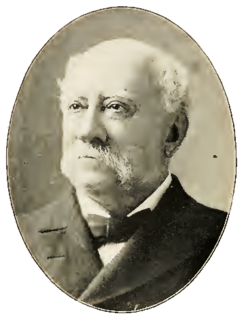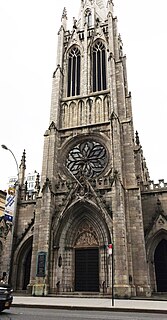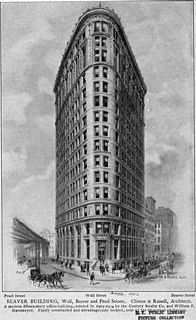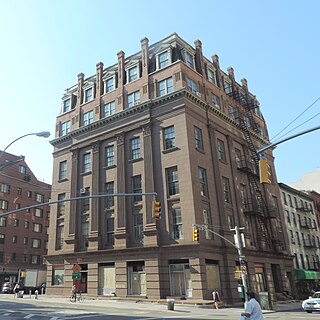


Joseph Trench (1815-1879) was an American architect who practiced in New York City and San Francisco in the 19th century.



Joseph Trench (1815-1879) was an American architect who practiced in New York City and San Francisco in the 19th century.
Trench was born in 1815, but little is known about his early history or training. By 1837 he was practicing in New York, and brought Jasper Francis Cropsey, who would go on to be a notable Hudson River School painter, into his office as an apprentice and draftsman. Several years later, in 1842, Trench took John B. Snook into Trench & Company, and Snook soon became the junior partner in the firm, which was later renamed to Trench & Snook. [1]
Trench moved to San Francisco in 1850 or 1851, and practiced as an architect there, designing among other buildings the Jenny Lind Theatre (1851), which later became San Francisco's City Hall, and the Metropolitan Theatre (1853). Trench also had other occupations, managing the Metropolitan Theatre and San Francisco Hall, and, later, became a prospector and miner. In 1856 he ran a mining operation in Mexico, and he formed the firm Sparrow, Trench & Company to run mines in the Nevada Territory. [1]
Trench, who never married, retired in the early 1870s, and died in East Oakland, California on August 27, 1879. [1]
Buildings designed by Trench's firm in New York City include: [1]
Trench also designed row houses which are part of the East 10th Street Historic District.

James Renwick Jr. was an American architect in the 19th century. The Encyclopedia of American Architecture calls him "one of the most successful American architects of his time".

Henry Janeway Hardenbergh was an American architect, best known for his hotels and apartment buildings, and as a "master of a new building form — the skyscraper."

Astor Place is a one-block street in NoHo/East Village, in the lower part of the New York City borough of Manhattan. It runs from Broadway in the west to Lafayette Street. The street encompasses two plazas at the intersection with Cooper Square, Lafayette Street, Fourth Avenue, and Eighth Street – Alamo Plaza and Astor Place Station Plaza. "Astor Place" is also sometimes used for the neighborhood around the street. It was named for John Jacob Astor, soon after his death in 1848. A $21 million reconstruction to implement a redesign of Astor Place began in 2013 and was completed in 2016.

Napoleon Eugene Charles Henry LeBrun was an American architect. He began his career in Philadelphia designing churches and theatres including St. Augustine's Church, the Cathedral-Basilica of Sts. Peter and Paul and the Philadelphia Academy of Music. He moved to New York City, established the firm Napoleon LeBrun & Sons and designed multiple additional churches. He became the official architect of the Fire Department of New York and designed 42 firehouses between 1879 and 1895. He also designed early skyscrapers in New York City such as the Metropolitan Life Insurance Company Tower and the Home Life Building.

Grace Church is a historic parish church in Manhattan, New York City which is part of the Episcopal Diocese of New York. The church is located at 800–804 Broadway, at the corner of East 10th Street, where Broadway bends to the south-southeast, bringing it in alignment with the avenues in Manhattan's grid. Grace Church School and the church houses—which are now used by the school—are located to the east at 86–98 Fourth Avenue between East 10th and 12th Streets.

New York City's Theater District is an area and neighborhood in Midtown Manhattan where most Broadway theaters are located, as well as many other theaters, movie theaters, restaurants, hotels, and other places of entertainment. It is bounded by West 40th Street on the south, West 54th Street on the north, Sixth Avenue on the east and Eighth Avenue on the west, and includes Times Square. The Great White Way is the name given to the section of Broadway which runs through the Theater District.

Clinton and Russell was a well-known architectural firm founded in 1894 in New York City, United States. The firm was responsible for several New York City buildings, including some in Lower Manhattan.

280 Broadway – also known as the A.T. Stewart Dry Goods Store, the Marble Palace, and the Sun Building – is a seven-story office building on Broadway, between Chambers and Reade Streets, in the Civic Center neighborhood of Lower Manhattan in New York City. Built from 1845 to 1846 for Alexander Turney Stewart, the building was New York City's first Italianate commercial building and one of the United States' first department stores. The building also housed the original New York Sun newspaper from 1919 to 1950 and has served as the central offices for the New York City Department of Buildings since 2002. It is a National Historic Landmark and a New York City designated landmark.
COOKFOX Architects is a firm of architects founded by Rick Cook and Robert F. Fox, Jr. in 2003. The firm works on both new projects and on the adaptive reuse of existing buildings. COOKFOX is best known for designing the Bank of America Tower at One Bryant Park.

The Odd Fellows Hall is a building at 165–171 Grand Street between Centre and Baxter Streets, in the Little Italy and SoHo neighborhoods of Manhattan, New York City. It was built in 1847–1848 and designed by the firm of Trench & Snook in the Italianate style, one of the city's earliest structures in this style, which Joseph Trench had brought to New York with his design for 280 Broadway in 1845. His partner, John B. Snook, was responsible for many cast-iron buildings in SoHo. The mansard roof was an addition, designed by John Buckingham and built in 1881–1882. The Independent Order of Odd Fellows used the building until the 1880s, when they moved uptown with the city's population. The building was afterwards converted for commercial and industrial use.

Stephen Decatur Hatch (1839–1894) was a prominent late-19th century architect who was responsible for a number of historically or architecturally significant buildings in Manhattan, New York City and elsewhere. He primarily designed commercial buildings.

Daniel D. Badger was an American founder, working in New York City under the name Architectural Iron Works. With James Bogardus, he was one of the major forces in creating a cast-iron architecture in the United States. Christopher Gray of The New York Times remarks: "Most cast-iron buildings present problems of authorship – it is hard to tell if it was the founder or the architect who actually designed the facade."
The brothers David, John E. and George Elliott Jardine were architects of Scottish nationality, sons of a Scottish architect-builder, Archibald Jardine, of Whithorn, Wigtownshire; they took up American citizenship and practiced in New York City, forming "one of the more prominent, prolific and versatile architectural firms in the city in the second half of the 19th century". From 1865 they practiced as David and John Jardine or D. & J. Jardine, later taking into partnership their brother George Elliott Jardine and Jay H. Van Norden. At David's death in 1892 the firm was reorganized as Jardine, Kent & Jardine and then practiced as Jardine, Hill & Murdock.

New York City Center is a 2,257-seat Moorish Revival theater at 131 West 55th Street between Sixth and Seventh Avenues in Midtown Manhattan, New York City, one block south of Carnegie Hall. City Center is a performing home for several major dance companies as well as the Encores! musical theater series and the Fall for Dance Festival. The center is currently headed by Arlene Shuler, a former ballet dancer who has been president since 2003. The facility houses the 2,257 seat main stage, two smaller theaters, four studios and a 12-story office tower.

John Butler Snook (1815–1901) was an American architect who practiced in New York City and was responsible for the design of a number of notable cast-iron buildings, most of which are now in and around the SoHo neighborhood of Manhattan, as well as the original Grand Central Depot, which preceded the current Grand Central Terminal.
Trench & Snook was an architecture firm in New York City in the mid-19th century which was a partnership of Joseph Trench, the senior partner, and John B. Snook, the junior partner. It evolved out of Joseph Trench & Company around the mid-1840s, several years after Snook joined the firm. After Trench left in 1850 or 1851, Snook practiced on his own under the company name. It later became John B. Snook & Sons after three of his sons and a son-in-law joined the firm.
Walter Danforth Bliss (1874-1956) was an American architect from California. Many of his buildings are listed on the National Register of Historic Places.

The Cable Building is located at 611 Broadway at the northwest corner with Houston Street in NoHo and Greenwich Village, in Manhattan, New York City. Since it spans a block, the Cable Building also has addresses of 2-18 West Houston Street and 178-188 Mercer Street.

Frank Aydelott Rooke, known professionally as Frank A. Rooke, was a New York architect who designed the historic Claremont Riding Academy and numerous other structures of significance that are either in National Historic Districts or listed on the National Register of Historic Places in the tri-state area.

Abraham Horace Albertson was an American architect who was one of Seattle, Washington's most prominent architects of the first half of the 20th century. He was born in New Jersey and educated at Columbia University in New York. Early in his career, he moved to Seattle in the employ of a well-known New York architectural firm with that was developing a large area in downtown. He worked on many projects in Seattle from around 1910 through the 20s and early 30s. Some of his designs are Seattle landmarks and/or listed on the National Register of Historic Places.